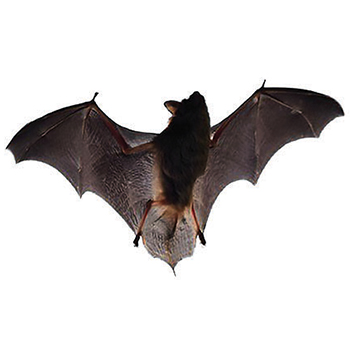Bat Control

Bats are surprisingly common pests in New Jersey, Delaware, Pennsylvania, and Maryland. While for the most part, bats are timid and peaceful creatures, they can also be carriers of severe diseases, and unwelcome guests in the attics and sheds that they turn into their temporary homes. If you detect bats in your home or business, it’s essential to take pest control measures to control them immediately by seeking the help and recommendations of wildlife control experts. To protect your home or business from bats, you need to learn about the behavior of this pest, take steps for prevention, and find effective treatment options should an infestation occur.
What Bats Are Common in My Area and How Can I Identify Them?
Bats are identifiable by their furry bodies and delicate wings. Bats are the only mammal in the world that can fly, and usually make their homes in caves and hollow trees. Over 1,000 different bat species have been identified throughout the world.
Although encounters between humans and bats are rare, there can be conflict when a bat stumbles into a business or residence, or when maternal bat colonies make their home in a seemingly unoccupied structure. Wildlife control experts explain there are 10 different species of bats within New Jersey, Pennsylvania, Maryland, and Delaware. These include:
- Little brown bat (Myotis lucifugus): Little brown bats are some of the most common bats found throughout the region. True to their name, these bats have dark glossy brown fur, often with black coloring around the shoulders. Little brown bats are one of the smaller species in the area, weighing 4 to 9 grams with a wingspan averaging 25 centimeters.
- Evening bat (Nycticeius humeralis): The evening bat is fairly small, weighing around 10 grams with a wingspan of approximately 27 centimeters. This is a rare species seldom seen in the area.
- Hoary bat (Lasiurus cinereus): Hoary bats are the largest bats found in Maryland, Pennsylvania, Delaware, and New Jersey, weighing up to 28 grams with a wingspan of up to 41 centimeters. Red, brown, or tan fur covers their bodies and tails, with silver-white coloring at the tips of the fur giving hoary bats a frosted appearance.
- Silver-haired bat (Lasionycterus noctivagans): This mid-sized tree bat has black wings and (as you may have guessed) silver fur. You’ll seldom find the silver-haired bat in the area during winter, as they commonly migrate south for the colder season.
- Eastern red bat (Lasiurus borealis): Eastern red bats are the most common tree bat found within Delaware, Pennsylvania, New Jersey, and Maryland, easily recognized by their bright reddish-orange colored fur. Moderate in size, the Eastern red bat has a wingspan of roughly 32 centimeters (just over one foot) in length.
- Tri-colored bat (Perimyotis subflavus): Although the tri-colored bat used to be commonly found in the U.S., the population has greatly dwindled with the spread of white-nose syndrome. The tri-colored bat is sometimes also known as the eastern pipistrelle or pygmy bat. This bat has dark fur at the base, light in the middle, and dark again at the tip.
- Eastern small-footed bat (Myotis leibii): The Eastern small-footed bat is one of the most diminutive bat species found in the U.S., and it weighs only 3 to 5 grams with a wingspan that tops out at 25 centimeters. The fur is golden brown in color, with a black mask around the face.
- Northern long-eared bat (Myotis septentrionalis): Around the same size as little brown bats, northern long-eared bats are distinguished by their long, pointed ears and extended tails. Northern long-eared bats are rarer than little brown bats, and there is relatively little known about their feeding and nesting habits.
- Big brown bat (Eptesicus fuscus): Big brown bats weigh up to 18 grams with wingspans up to 40 centimeters, making them roughly twice the size of little brown bats. You can easily recognize them with their large size, uniform coloration, and black wings.
How Did I Get Bats?
Bats naturally live in caves and hollow trees. Wildlife control experts explain in many areas in New Jersey, Pennsylvania, Maryland, and Delaware, human development has made bat habitats scarce, and so these highly adaptable creatures often make their homes in unoccupied structures, including sheds, garages, and the rafters of homes or business buildings. Maternal colonies raising their young favor attics for their warmer temperatures. Bats can enter surprisingly small areas, and their entry points can be anything from an unscreened attic vent to a crack in the siding or a hole under the eaves. If a colony of bats finds a way into your home or business for raising young, they’ll usually return every year.
Wildlife control experts state the only way to effectively prevent bats from entering your home or business is to properly seal entrances. Seasonal maintenance can help you identify and eliminate entry points. Another way to learn how to keep bats away is through the recommendations of humane bat control from the wildlife control experts at Viking Pest.

What Are the Effects of Bats in and Around My Home or Business?
Bats nesting in your NJ, PA, MD, or DE home or business can be a nuisance. For one thing, bat droppings (also known as guano) and nests can cause allergies, unsightly marks, and unpleasant odors. However, the most serious problem with a bat infestation is that bats can be carriers of disease. Bat guano can contain airborne fungus spores that can cause histoplasmosis. While this is rare, it can become severe, causing influenza-like symptoms, pneumonia, and even death. Bats can also carry mites, fleas, and ticks.
Wildlife control experts warn although bats rarely bite humans they can, like most wild animals, be carriers of rabies. Bat bites are often small and can even go unnoticed. Therefore, if you find signs of a bat in an area with children, sleeping individuals, or people suffering from dementia or another issue that could render them disabled, the CDC recommends that they be tested for rabies as soon as possible.
How Long Do Bats Live?
Depending on the species, the life expectancy of bats can be 20 to 40 years in the wild. Wildlife control experts explain this means that if bats start nesting in a certain area, you can expect them to return to that same place every year for decades unless something deters or bars them from returning.
How Do I Prevent Bats?
The best way to prevent bats from entering your home or place of business is to conduct regular inspections of the building to ensure there are no entry points. The wildlife control experts at Viking Pest recommend checking in these spaces:
- Spaces between the walls and holes created for utility lines and airflow
- Under the eaves
- Chimney flues
- Holes and cracks in damaged siding, fascia, or soffits
Because most bat species are protected in New Jersey, Delaware, Pennsylvania, and Maryland and in need of careful conservation, bat pest control issues must be handled with the utmost care. Viking Pest handles pest bats with humane techniques that have been proven effective. Using expert pest control knowledge of bat habits and behaviors, Viking is able to install strategic prevention measures to keep bats away. If bats are already in your home or business, an exclusion process is the best way to eradicate the infestation. Our highly experienced wildlife control technicians install one-way doors that allow bats to leave for feeding but bar them from re-entering the structure. This method is highly effective and usually eliminates the pest bat population within a number of days. Bat exclusion provided by the wildlife control experts at Viking Pest can be performed April 1st – April 30th, and August 1st – October 15th. As stated by the NJ Division of Fish and Wildlife, these dates are observed as “safe dates” to perform bat exclusion for nuisance wildlife so bats are not harmed in the process of humane exclusion.
Bat Exclusion During Maternity Season
Bat exclusion can legally be performed April 1 – 30 and August 1 – October 15 as stated by the NJ Division of Fish and Wildlife. These guidelines protect bats and people by ensuring exclusion is done effectively, working with the bats’ natural rhythms. Performing exclusion work outside of these windows is more likely to result in bats getting into your living space and/or cause illegal harm to the animals. If bats are invading your home outside of the legal exclusion window, please read below.
- Our wildlife control experts can block openings between the bats’ roost and human living areas (i.e. the space beneath the attic door, holes in ceilings or walls, etc.) at any time of year since doing so will not disturb or trap bats. This is a preventative measure to keep bats from coming into contact with people or pets inside the home.
- For health-related concerns, residents should contact their local health department.
- You can find more info on the NJ Division of Fish and Wildlife Bat Conservation webpage and Bats in Buildings page.
Can Bats Spread COVID-19?
People cannot contract COVID-19/SARS-CoV-2 virus from bats.














